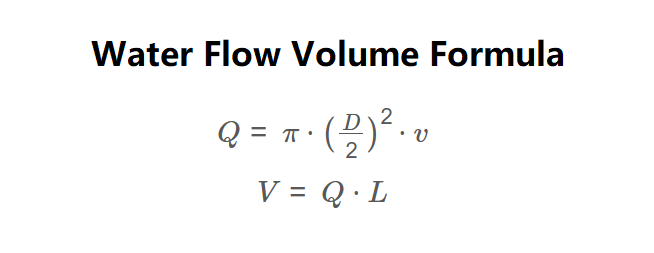1. What is the Water Flow and Total Volume Calculator?
Definition: This calculator computes the volumetric flow rate (\( Q \)) and total volume (\( V \)) of water flowing through a pipe, based on the pipe's diameter, water velocity, pipe length, and fluid density. It supports multiple units for inputs and outputs, making it versatile for hydraulic engineering, plumbing, and fluid dynamics applications.
Purpose: Engineers, plumbers, and designers use this tool to determine the volume of water delivered through a pipe over its length, aiding in system design, water management, and ensuring adequate flow for various applications.
2. How Does the Calculator Work?
The calculator uses the following formulas, as shown in the image above:
\( Q = \pi \cdot \left(\frac{D}{2}\right)^2 \cdot v \)
\( V = Q \cdot L \)
Where:
- \( Q \): Volumetric flow rate (base unit: cubic meters per second, m³/s);
- \( V \): Total volume (base unit: cubic meters, m³);
- \( D \): Pipe diameter (base unit: meters);
- \( v \): Water velocity (base unit: meters per second, m/s);
- \( L \): Pipe length (base unit: meters);
- \( \rho \): Fluid density (base unit: kg/m³, used for validation);
- \( \pi \): Mathematical constant, approximately 3.14159.
Steps:
- Enter the pipe diameter (\( D \)) and select its unit (m, cm, mm, in, ft).
- Enter the water velocity (\( v \)) and select its unit (m/s, cm/s, ft/s, km/h, mph).
- Enter the pipe length (\( L \)) and select its unit (m, cm, ft, in, km, mi).
- Enter the fluid density (\( \rho \)) and select its unit (kg/m³, g/cm³, lb/ft³, lb/in³); defaults to 1000 kg/m³ for water.
- Select the output units for volume (\( V \): m³, L, cm³, ft³, gal) and flow rate (\( Q \): m³/s, L/s, ft³/s, gpm).
- The calculator converts inputs to SI units, computes \( Q = \pi \cdot (D/2)^2 \cdot v \), and calculates \( V = Q \cdot L \).
- Results are converted to the selected output units, formatted (scientific notation for values < 0.001, otherwise 4 decimal places), and displayed for volume and flow rate.
3. Importance of Water Flow and Volume Calculation
Calculating flow rate and total volume is essential for:
- System Design: Ensures pipes are sized to handle required flow and volume, preventing pressure loss or overflow.
- Water Management: Determines the total water volume delivered, critical for irrigation, water supply, or storage systems.
- Safety and Efficiency: Avoids issues like pipe erosion or water hammer by maintaining appropriate velocities and volumes.
4. Using the Calculator
Example 1: Calculate the total volume and flow rate for a pipe with a diameter of 4 inches, velocity of 5 ft/s, length of 100 feet, density of 1000 kg/m³, outputting volume in gallons and flow rate in gpm:
- Diameter: 4 in = 0.1016 m;
- Velocity: 5 ft/s = 1.524 m/s;
- Length: 100 ft = 30.48 m;
- Flow Rate (\( Q \)): \( \pi \cdot (0.1016/2)^2 \cdot 1.524 = 0.01236 \, \text{m}^3/\text{s} = 195.9676 \, \text{gpm} \);
- Total Volume (\( V \)): \( 0.01236 \cdot 30.48 = 0.3767 \, \text{m}^3 = 99.4969 \, \text{gal} \).
Example 2: Calculate the total volume and flow rate for a pipe with a diameter of 20 cm, velocity of 2 m/s, length of 50 meters, density of 1 g/cm³, outputting volume in liters and flow rate in L/s:
- Diameter: 20 cm = 0.2 m;
- Velocity: 2 m/s;
- Length: 50 m;
- Density: 1 g/cm³ = 1000 kg/m³;
- Flow Rate (\( Q \)): \( \pi \cdot (0.2/2)^2 \cdot 2 = 0.06284 \, \text{m}^3/\text{s} = 62.84 \, \text{L/s} \);
- Total Volume (\( V \)): \( 0.06284 \cdot 50 = 3.1420 \, \text{m}^3 = 3142.0 \, \text{L} \).
5. Frequently Asked Questions (FAQ)
Q: How accurate is the volume calculation?
A: The formulas are precise for laminar flow in circular pipes with accurate inputs. Real-world factors like turbulence or pipe roughness may introduce minor errors.
Q: Why is fluid density included if it’s not used in the calculation?
A: Density is included for validation and potential future calculations (e.g., mass flow rate). For water, it defaults to 1000 kg/m³.
Q: Why are there multiple output units for volume and flow rate?
A: Different industries prefer different units (e.g., liters for water supply, gpm for U.S. plumbing). Flexible output units ensure usability across applications.
Water Flow and Total Volume Calculator© - All Rights Reserved 2025
 Home
Home
 Back
Back
